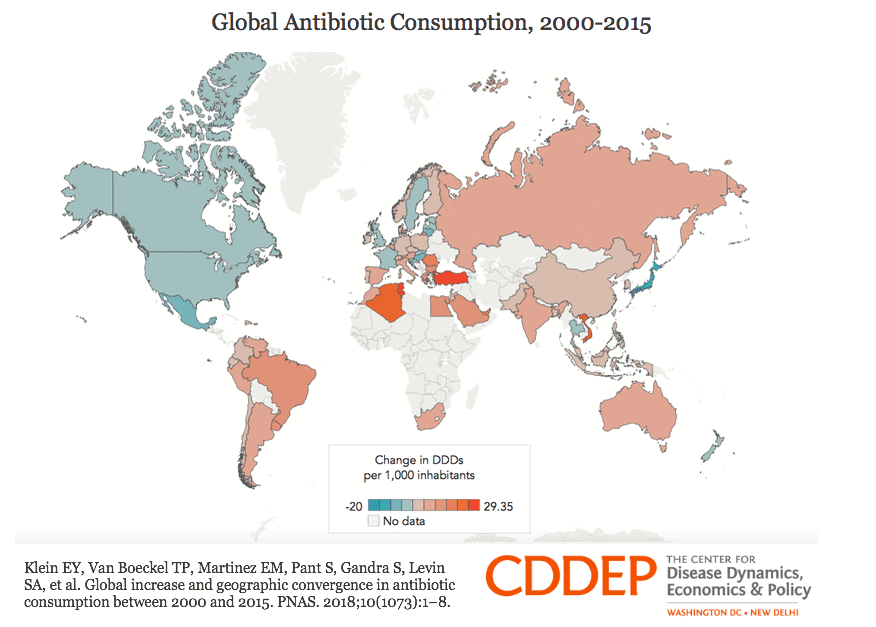October 21, 2019

Doctors are overtesting urine and overprescribing antibiotics. A recent New York Times article outlines the overprescription of antibiotics influenced by positive cultures picked up in urine tests from asymptomatic patients. This issue is particularly common among older patients. Public health professionals have tried and failed to prevent doctors from inappropriately prescribing antibiotics when they receive a positive urine culture from an asymptomatic patient for fear of missing an infection. Now, concerned professionals have resorted to encouraging physicians to refrain from requesting urine tests for asymptomatic patients in the first place. [NYTimes]
Neonatal rotavirus vaccine schedule decreases child mortality in LMICs. A modelling analysis of 135 low- and middle-income countries (LMICs) estimated that a 3 dose schedule of the rotavirus vaccine administered along with the diphtheria–tetanus–pertussis vaccine could reduce rotavirus gastroenteritis deaths among children 0-5 years old by 38 percent. This schedule increased excess intussusception deaths by just 1.4 percent compared to no vaccination. This neonatal schedule could be more effective at preventing rotavirus gastroenteritis deaths and causing fewer excess intussusception deaths in children compared to the current World Health Organization recommended vaccine schedules. [The Lancet Global Health]
Post-discharge antibiotic exposure is high across US healthcare network. A retrospective analysis using national Veterans Health Administration data between 2014 and 2016 found that 39 percent of antimicrobial exposure among acute care patients occurred post-discharge. Median inpatient antimicrobial exposure was 331.3 days of therapy per 100 admissions, while median outpatient exposure was 209.5 days of therapy per 100 admissions. The most common post-discharge antimicrobial were fluoroquinolones (38.3 percent). [Clinical Microbiology and Infectious]
HPV vaccine demonstrates herd immunity in young men. Researchers identified a decline in vaccine-type human papillomavirus (HPV) prevalence among young men (aged 14-26), vaccinated and unvaccinated, between two waves of data collection (2013-14 and 2016-17) in a Midwest metropolitan area of the US. Infection with at least one vaccine-type HPV decreased 31 percent among all men and 36 percent among unvaccinated men, suggesting the benefit of herd protection from the vaccine. [Vaccine]
Worldwide AMR recommendations lack progress. The Review of Progress on Antimicrobial Resistance (AMR) report, which was released earlier this month by Chatham House, notes a lack of progress in addressing several 2016 recommendations to combat AMR. The progress report highlights that the 2016 Review on Antimicrobial Resistance was effective at raising awareness on AMR globally and stimulating new initiatives to combat the issue, but failed to transform research and development incentives for antibiotics, vaccines, and diagnostics. Since the 2016 Review, there have been advances in AMR awareness, reductions in antibiotic use in agriculture, and investments in antibiotic use and resistance surveillance among humans. [Chatham House]
Resistant bacteria and genes identified in Algerian farms. Researchers identified 103 colistin-resistant strains of bacteria isolated from soils, irrigation water, and manure from farms in northwest Algeria. Eight Escherichia coli strains were isolated, of which all were resistant to amoxicillin, amoxicillin-clavulanate, ticarcillin, nalidixic acid, ciprofloxacin, gentamicin, trimethoprim-sulfamethoxazole, and rifampicin. Six of the strains were carrying mcr-1 gene and 2 were carrying mcr-3 gene. The study suggests that farms act as a reservoir for the transfer of resistance genes, which could eventually affect humans. [Journal of Global Antimicrobial Resistance]
Patients receiving laxatives should not be excluded from C diff testing. Researchers at Beth Israel Deaconess Medical Center found similar rates of patients meeting severe Clostridioides difficile infection criteria among those receiving laxatives and those not receiving laxatives (66.2 percent versus 56.3 percent, p = 0.224). Results suggest that the Diseases Society of America-Society for Healthcare Epidemiology of America’s guidelines, which recommend excluding patients from C. diff stool testing if they have recently received laxatives, are not supported by evidence. [Clinical Infectious Diseases]
Flu and pertussis vaccination is lacking among pregnant women.The US Centers for Disease Control and Prevention (CDC) reported that 65 percent of pregnant women have not been vaccinated against influenza and pertussis (whooping cough), two vaccines recommended during pregnancy to protect mothers and their newborns from complications from the diseases. Pregnant women with the flu are more than twice as likely to be hospitalized compared to non-pregnant women, and nearly 70 percent of whooping cough deaths occur in infants <2 months old. [CDC]
High rates of women are mistreated during childbirth in low- and middle-income countries. A study consisting of labor observations and surveys of mothers up to 8 weeks postpartum across Ghana, Guinea, Myanmar, and Nigeria found that more than one-third of women experienced mistreatment during childbirth. Mistreatment consisted of physical abuse, verbal abuse, stigma, and/or discrimination. Younger women aged 15-19 with no or some education were more likely to be verbally abused during childbirth than older women 30+ (OR=3.6, 1.6), and a large proportion of women who received episiotomies (75.1 percent of observed and 56.1 percent of surveyed women)or cesarean sections (13.4 percent of observed and 10.8 percent of surveyed women) did not formally agree to the procedures. [The Lancet]
Age and sex differences impact HIV rates among young African girls. According to an analysis of 51 studies across nine African countries, HIV incidence rates among females aged 15-24 were high in KwaZulu-Natal, South Africa, Zimbabwe, and Ugandan fishing communities, and highest among female sex workers in South Africa (13.2 cases per 100 person-years). HIV rates were lowest among 13–19 year old girls in Kumi, Uganda (0.38 cases per 100 person-years). The greatest sex differences were reported between females aged 15-19 and their male counterparts in Southern and Eastern Africa (pooled RR: 5.94, 3.22). [The Lancet Global Health]
Changes in global antibiotic consumption between 2000 and 2015. [CDDEP]












